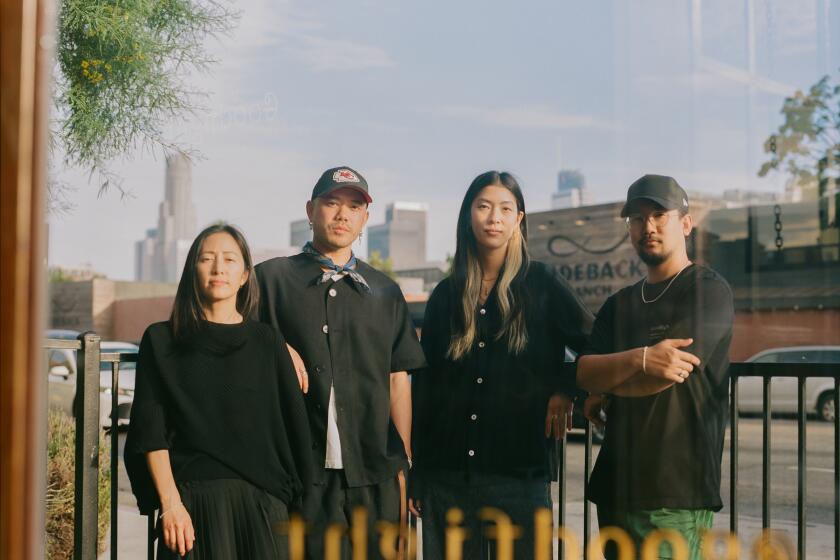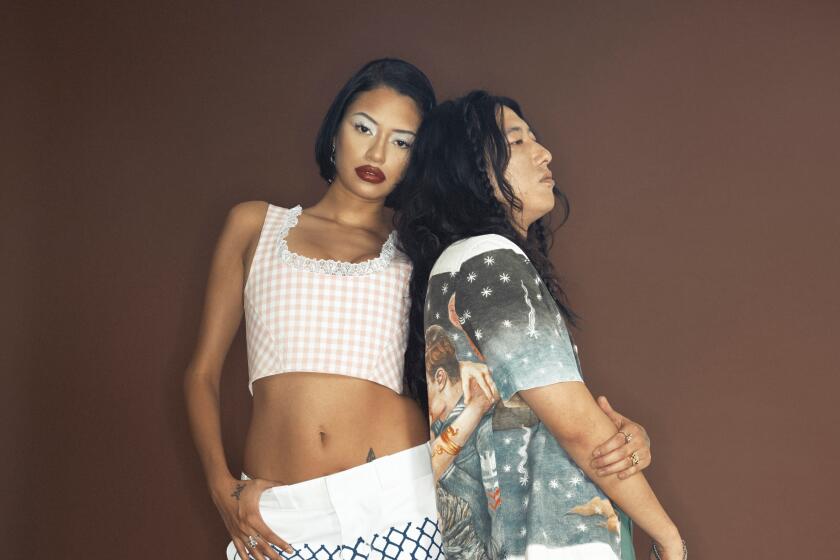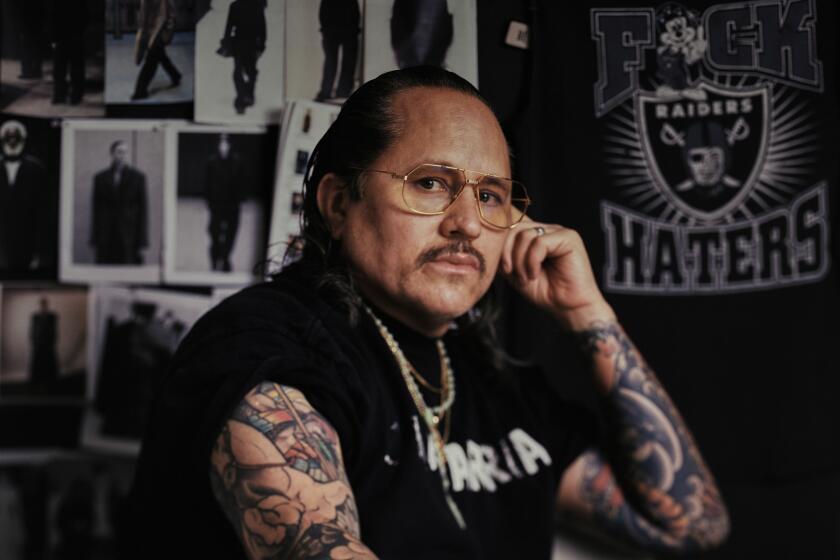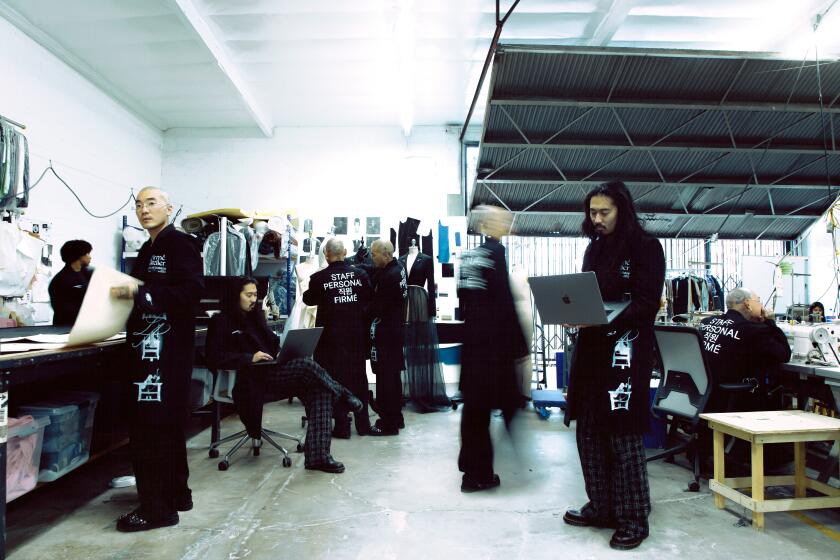- Share via
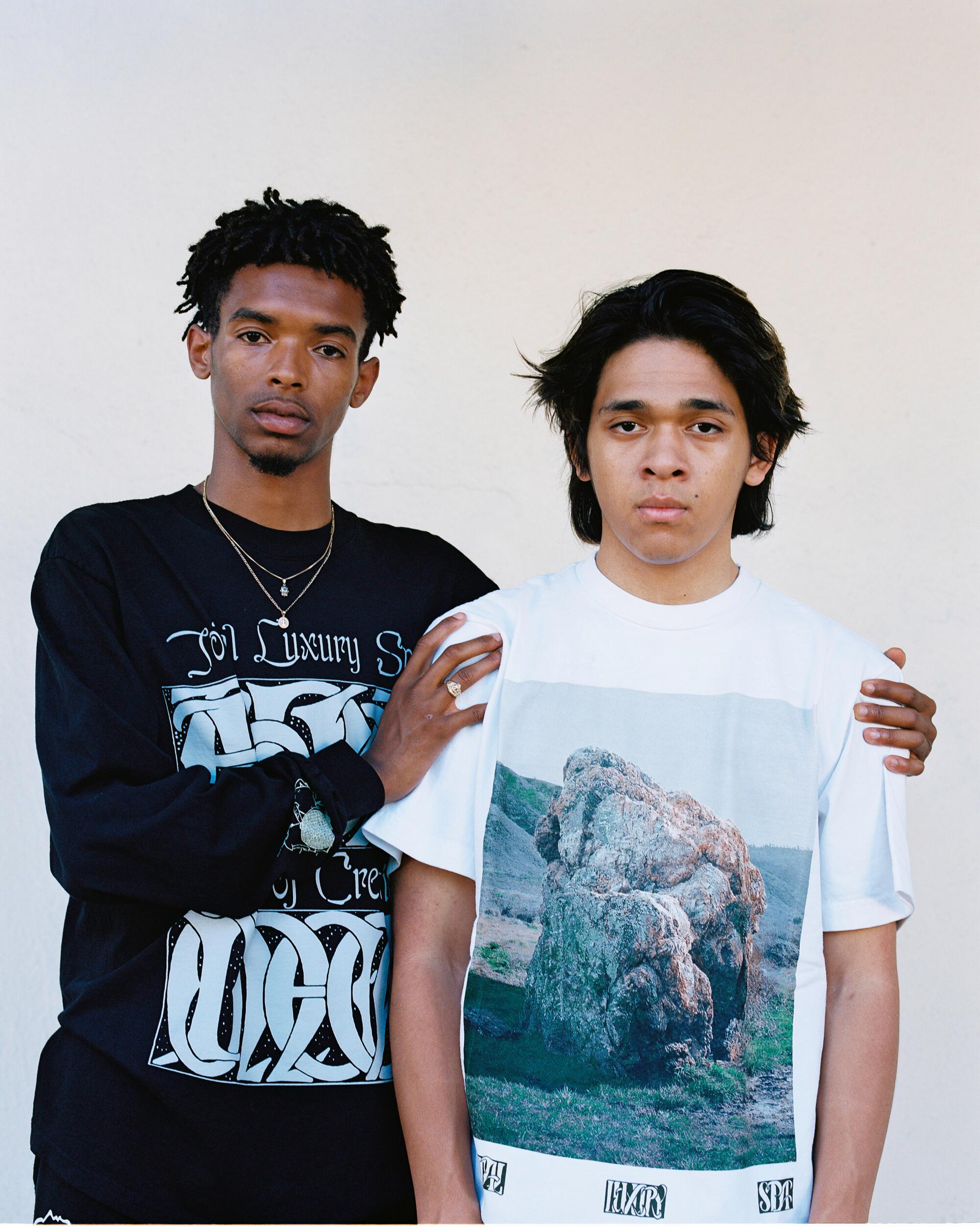
This story is part of Image issue 21, “Image Makers,” our third annual celebration of the homegrown fashion luminaries who are designing a global fashion future built from the L.A. that was. Read the whole issue here.
The scent inside the Spa is palo santo. It welcomes you in with its hazy aroma. Infuses the air with a smoky invitation to stay a while. This is what all great spas do: they beckon you to post up. Conversations follow suit; ideas really start flowing when the energy is right.
Daniel DeSure, the owner and founder of the art practice Total Luxury Spa, and the studio behind it, Commonwealth Projects, has a similarly warm presence. He created TLS in 2012 as a kind of retreat, where the community “could go and just do whatever we wanted to.” It was a space to inhabit, to find communion, to bond, to share ideas. Early on, TLS took the form of a poster, a zine, a film, a talk. Later, the medium became T-shirts.
At its core, Total Luxury Spa asks: What can a T-shirt do? Graphics — artful depictions of words — are a form of articulating new ideas and new possible pathways. DeSure, who has always found inspiration in cultural artifacts, often pulls from his deep archives — printed matter, books — as well as from artists, like his good friend, the late Noah Davis. TLS is rooted in institutional knowledge. L.A.’s artistic community — from Lauren Halsey to Martine Syms to Cauleen Smith — has always been integral to the mission. So have the TLS team and Commonwealth Projects. The Spa is a space to tell new stories, DeSure, 44, says, about “where things are at now, or where we’d like them to be in the future.”
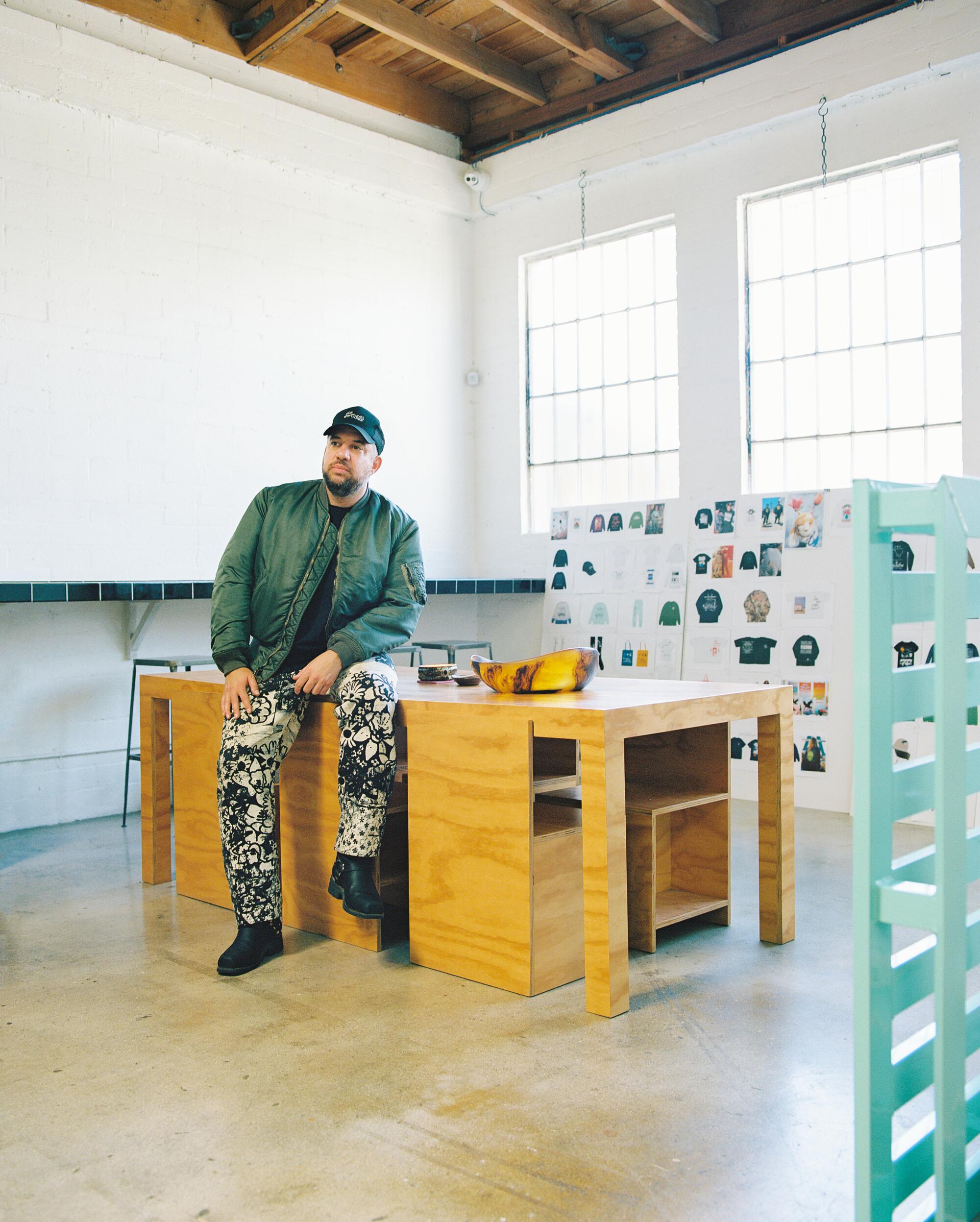
Ian F. Blair: What is Total Luxury Spa?
Daniel DeSure: Before anything else, it’s an art practice. A lot of people call it streetwear, because it does sort of have a hand in that. But I don’t consider [us] a streetwear company. I also think that there’s a whole ecosystem that functions sometimes like a high school at times. We don’t really put out line sheets like in a traditional fashion season calendar. We do it when it feels right. We can only talk about Total Luxury Spa with Commonwealth Projects side by side because Commonwealth Projects, which is the studio behind Total Luxury Spa, works with artists all the time. One of the first things we ever did was put out zines of emerging artists, young artists that we were into that didn’t have gallery representation.
IFB: Tell me about these zines.
DD: Growing up, collecting books, collecting zines, printed matter — my friends would probably consider me a hoarder when it came to any printed matter. Posters, array of fliers, show fliers, tickets …
Smart fashion is not about an aesthetic. The brand once called a cross between Comme des Garçons and Levi’s knows that it’s about putting something extra on it just for you.
IFB: What was the zine that changed it all?
DD: It was a piece of printed matter. There was a group out of Laguna Beach called the Brotherhood of Eternal Love. They were a bunch of surfers, hippies — this is the late ’60s, early ’70s. They were surfing around Morocco and the Middle East, and they were bringing in hashish and started making acid. They were basically like, “Everyone should be turned on and free and sort of liberated as possible.” I had come across articles of incorporation, where they incorporated themselves as a religious institution, and called themselves the Brotherhood of Eternal Love. They did it to be able to basically sell drugs and get out of taxes. There’s a lot of those ideals that I’m actually not really super in line with, some I am, but I think it was this piece of printed matter that highlighted a really specific time, and a specific type of people that were looking to do things a different way. In some ways, that piece of paper represented just as much as what I learned in art school [at CalArts]. “Oh, you can make something and communicate with people in a different way?” That was maybe the most eye-opening piece of printed matter that I had gotten back in the day.
IFB: So you went to CalArts.
DD: I went to CalArts for two years; I studied experimental film and video. This was the early 2000s. I started working with Doug Aitken, the video artist, and I was helping run his studio. I started traveling with him, watching him make films. I got to experience exhibition design [and] all the collateral that would go into an exhibition — the books and posters and branding that went into the making of it. And that gave me the tools for how to do it. I came back to school after my second year, and James Benning, who was my mentor at the time in school, a video artist [and filmmaker], told me, “Either stay in school or go work. This is not going to work if you’re doing both.” I was learning more outside of school than I was in school, and so I dropped out and started working with Doug. That gave me the real foundation of how the world works a little bit more, having to do things under a tight budget and putting a book together. That, to me, was the real boot camp.
IFB: Where did you grow up?
DD: I grew up in the Valley. I was actually born in Ohio, moved when I was really young, like 3, and then moved to the Valley, lived in Reseda for a long time. I still have a real draw to the Valley.
IFB: How do you feel about the Nicolas Cage movie “Valley Girl”?
DD: Love it.
IFB: What’s your favorite Valley movie?
There’s a classic feeling to L.A.’s favorite regalia that transcends genre and class. Every time you freak it, you step into a high-fashion world that is all your own.
DD: I’m obsessed with “Magnolia.” [Paul Thomas Anderson] shows the in-between in the Valley — there’s a real specific suburban look, these mom-and-pop storefronts located between a bar and some sort of vape shop. He really shows that as a background of his films. This is not the Valley, but an L.A. movie that is incredible is Michael Mann’s “Collateral” — the way they shoot L.A., the camerawork, how they travel around the city. More than anything [it reveals] the lighting. L.A. is like dusty neon. It’s like the dirt on your windshield and you’re driving at night and the taillights on the cars are all blurry. To me, that’s L.A.
IFB: So you go to CalArts, drop out of CalArts. How does Total Luxury Spa come about?
DD: I left Doug’s studio and started Commonwealth Projects with a specific focus on exhibition design, publication design. I was always in books, publication design, but it was more art-focused. Then, somewhere around the mid-2000s, there was a real intersection of fashion and art, which I hadn’t seen really before. All of a sudden, you had Saint Laurent or Dior wanting to do these exhibitions. We were sort of in a perfect place at the perfect time when we started doing more of that kind of work — exhibition design, but specifically in the fashion space. That exposed me to the clothing thing. But what it did was it gave us this energy to look at all these other spaces, what we wanted to do.
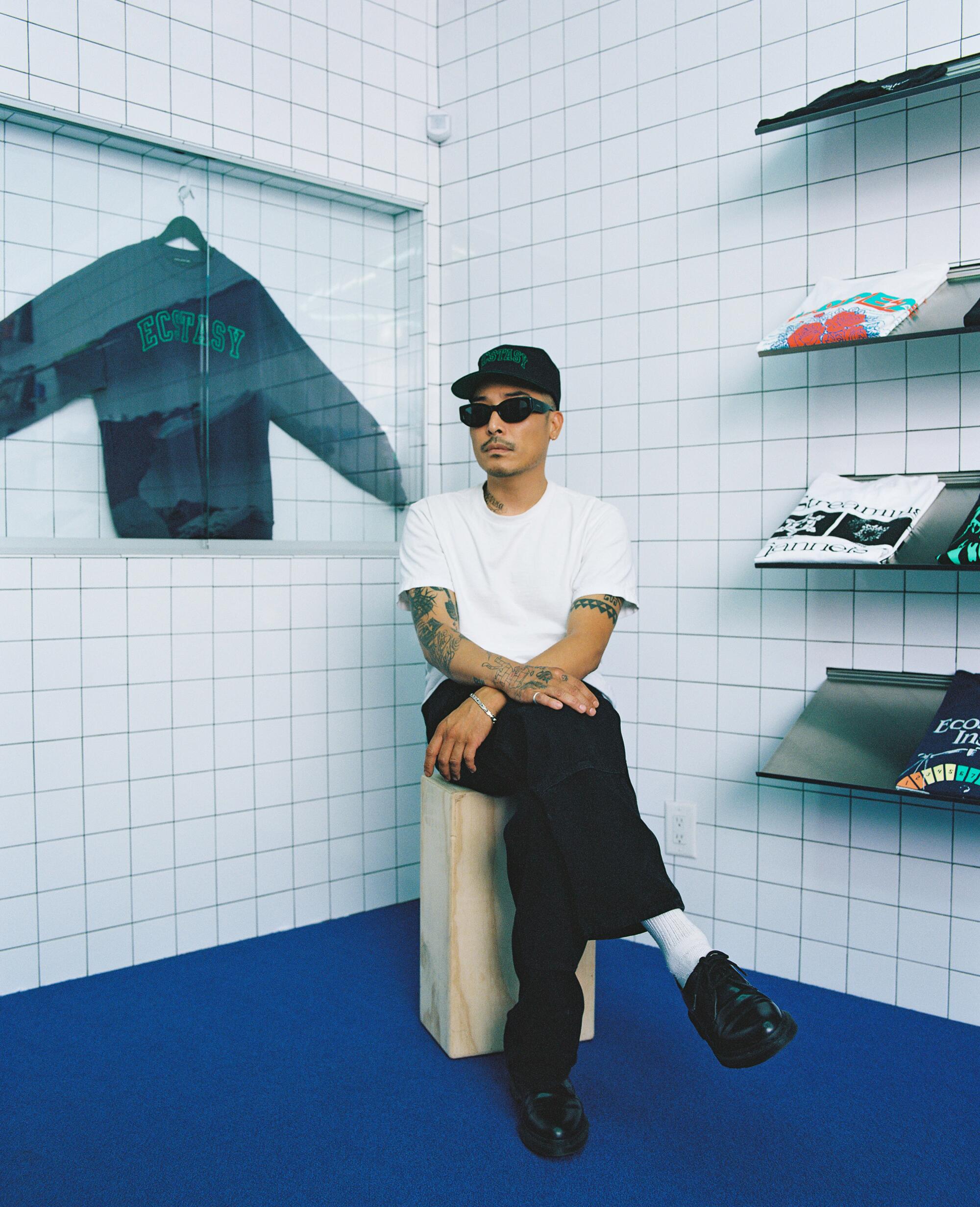
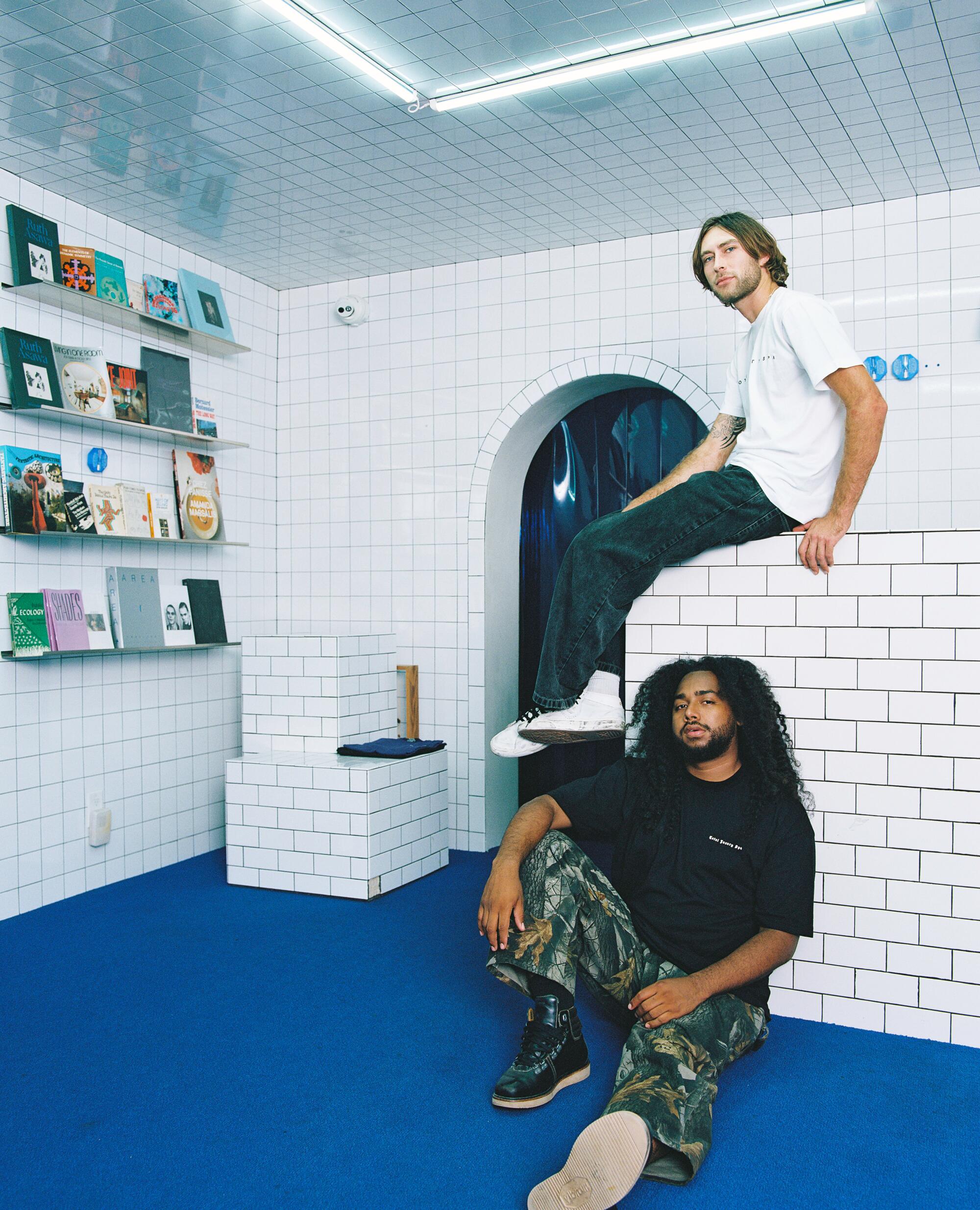
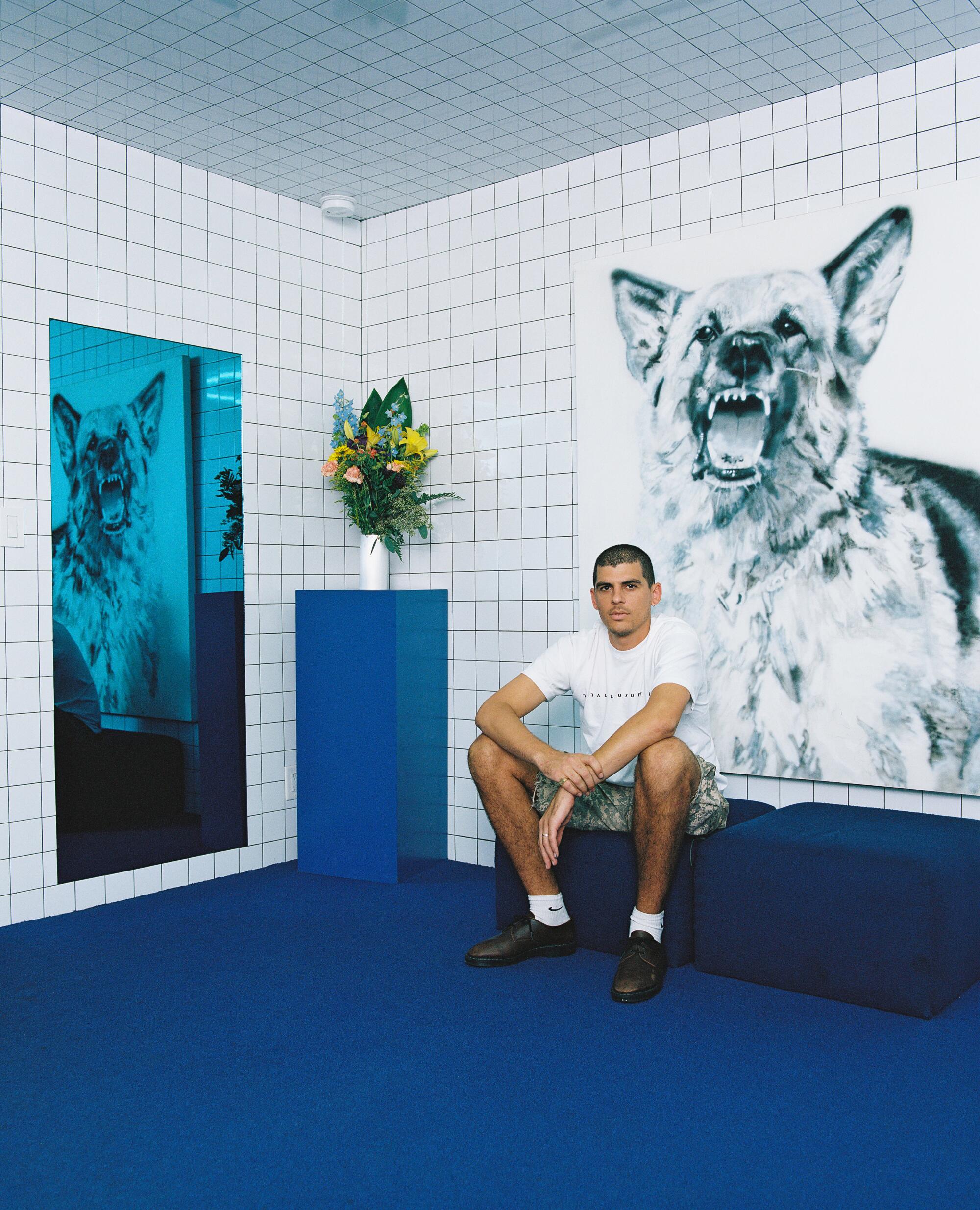
[In] 2011 or 2012, I started feeling a little bit burnt out on [client-based] projects. We were looking to exercise a different type of design muscle. Also at the time, the community was really building — we were just hanging out with artists through Commonwealth. A lot of those artists didn’t have representation; they were just young emerging artists that we were interested in. I started doing some zines. They were really small, but with each one, we would have a little event. We might show a movie. I think that was my first understanding that the community wants to come together. There’s all these people and they’re looking for things to do. All these people from different walks of life, people that would maybe normally be kind of intimidated by fine art, started showing up.
IFB: How did you pay for this?
DD: Commonwealth paid for it. We were doing these commercial projects, and I put money aside and put it into stuff I was interested in: a zine or film series or a talk. That’s essentially how Total Luxury Spa was started. It never started as a clothing brand. As we were doing these events and bringing artists into the fold, we started doing a couple shirts, just fun T-shirts. I think we made like 100, and there were a couple samples here. Khalil Joseph wore one of those samples in the New York Times and then it just took off.
IFB: Were you calling it Total Luxury Spa?
DD: It was always called Total Luxury Spa from the beginning, from when we put the first zines out.
IFB: Where does the name come from?
‘No matter what I’m doing, you’ll always know where I’m from, my influences and my culture.’
DD: We would call it “Spa” at the time, which was our nickname for it. Because Commonwealth was doing these fairly buttoned-up projects that were commercial — you have to sort of answer to a client, budgets and things like that. Spa was our retreat where we could go and just do whatever we wanted to — a poster, a zine, a film, a talk.
We started thinking about this idea of luxury. What does luxury mean? Water can be a luxury; air can be a luxury. We start thinking about exposing people, ourselves, to new types of information as a luxury. And so, this idea came up that, what if, instead of a spa or a wellness center — instead of there being a sauna room or a eucalyptus room, or a cold plunge, what if one room was a room for meditation? What if another room was a listening room and had all the records in the world? What if another room was a library? Because we couldn’t afford a physical space in the beginning, we’re like, let’s just make up the space. What if the space just put out a book? What if the space put out a shirt? What would the shirt look like?
IFB: How can you not love just wearing “True Sensation”?
DD: All of the graphics have always come from our inspiration. We’ve always been inspired by people who have done things before us.
IFB: How do you find the graphics?
DD: I’ve collected so many books over the years. And everyone that we work with — Justin Sloane, Andrew Hogge, incredible designers — before they were even designers, they’ve just been collectors. We’ve always been interested in collecting imagery and graphics, fliers and books. We get off on sharing those with each other.
IFB: So the group DM is pretty strong.
DD: It’s absolutely insane.
We’ve always been interested in stories of the past. In terms of the graphic recipe for Total Luxury Spa, a lot of times it’s conversations or ideals of the past, told through graphics that we really respect. And then we always give it a new twist. All these utopian ideas of the ’60s and ’70s, I always found really interesting — in some ways, a lot of those things failed. We’re not at that place. Back then, they were about living in a utopian way where the government worked for the people.
IFB: Formulating new ideas and new possible pathways.
DD: Totally. For us, it’s about bringing a lot of those graphics as a base to tell a new story, or kind of where things are at now, or where we’d like them to be in the future. Sometimes we tell it in a really big, bold way. Sometimes it’s just a shirt that says “True Sensation,” pulled from a rave-inspired flier or something like that. But the idea behind raves and parties is this idea of celebrating life and living freely and really enjoying life.
IFB: I’m very curious about the power of archiving, and I’m also very interested in what it means to bring it back to life.
DD: I look at shirts as a vessel, and that vessel is for communicating. It’s a visual medium. When we think about archiving, and reframing things and having conversations, the shirt is the medium for telling a story. Some of the most incredible artists I know are archivists, and I think part of that is rarely someone inventing something new, completely from scratch. You sort of take an ideal, where someone else left off, and you run with it. That’s the beauty of humanity. I think if you mix that recipe with a little bit of empathy for others …
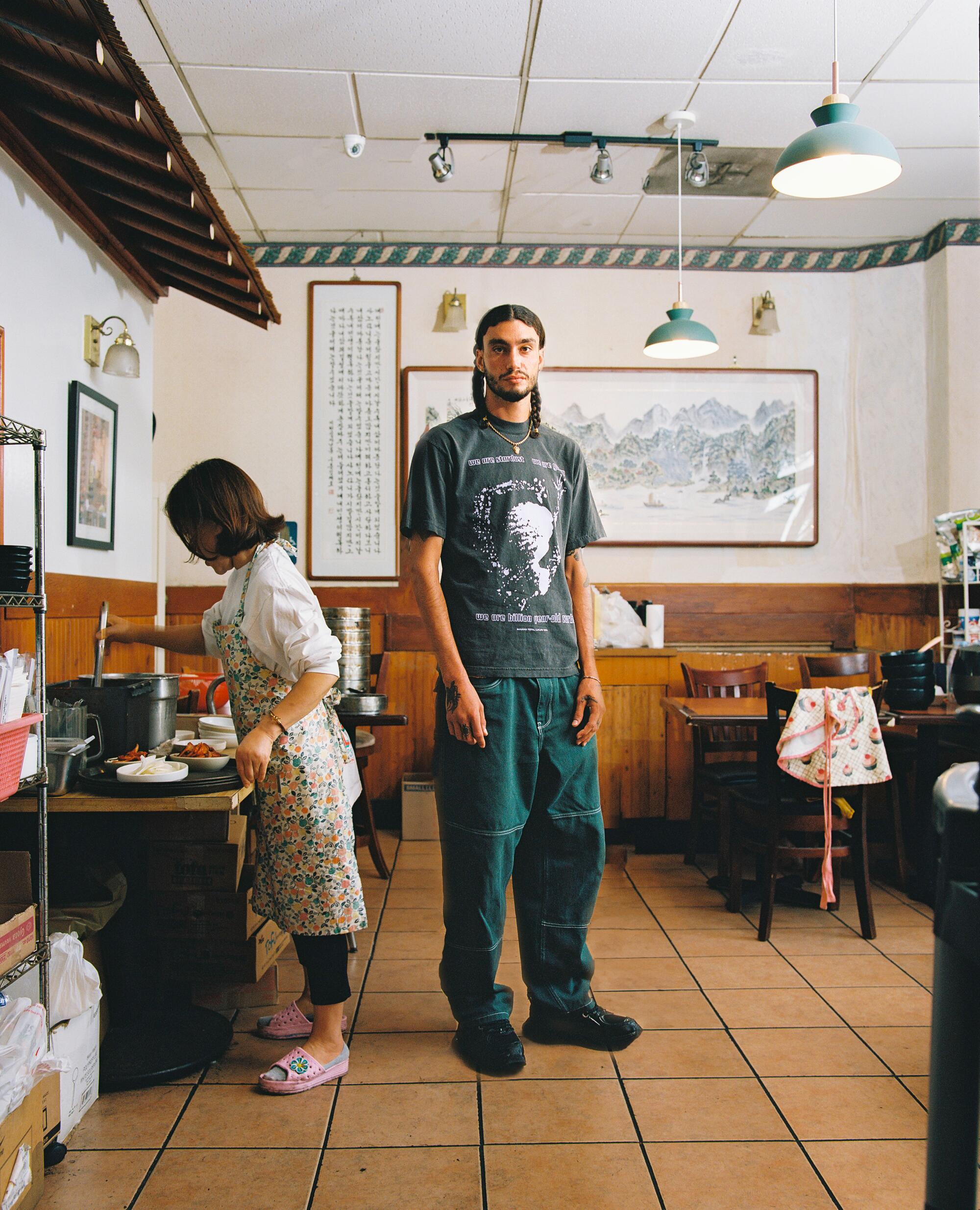
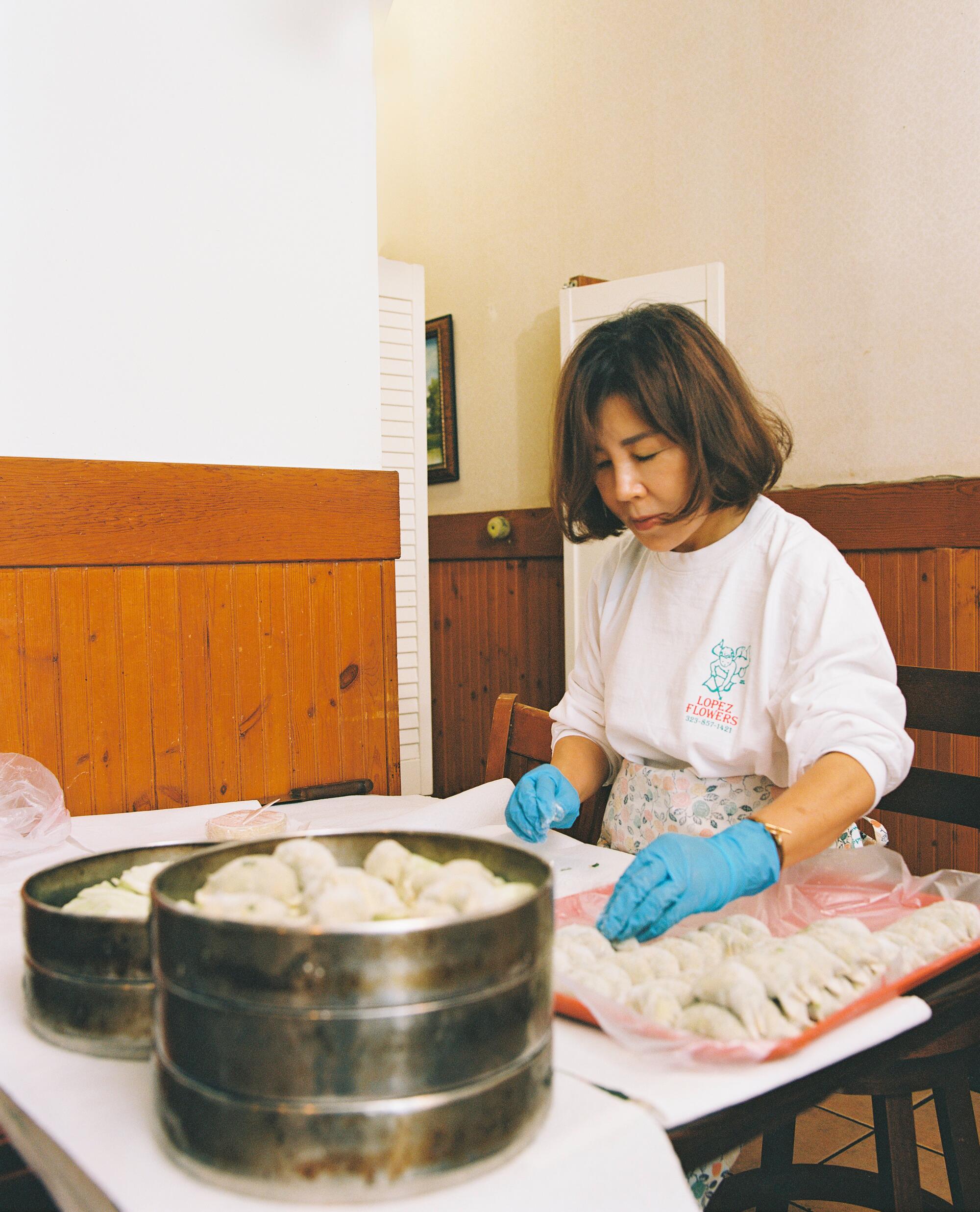
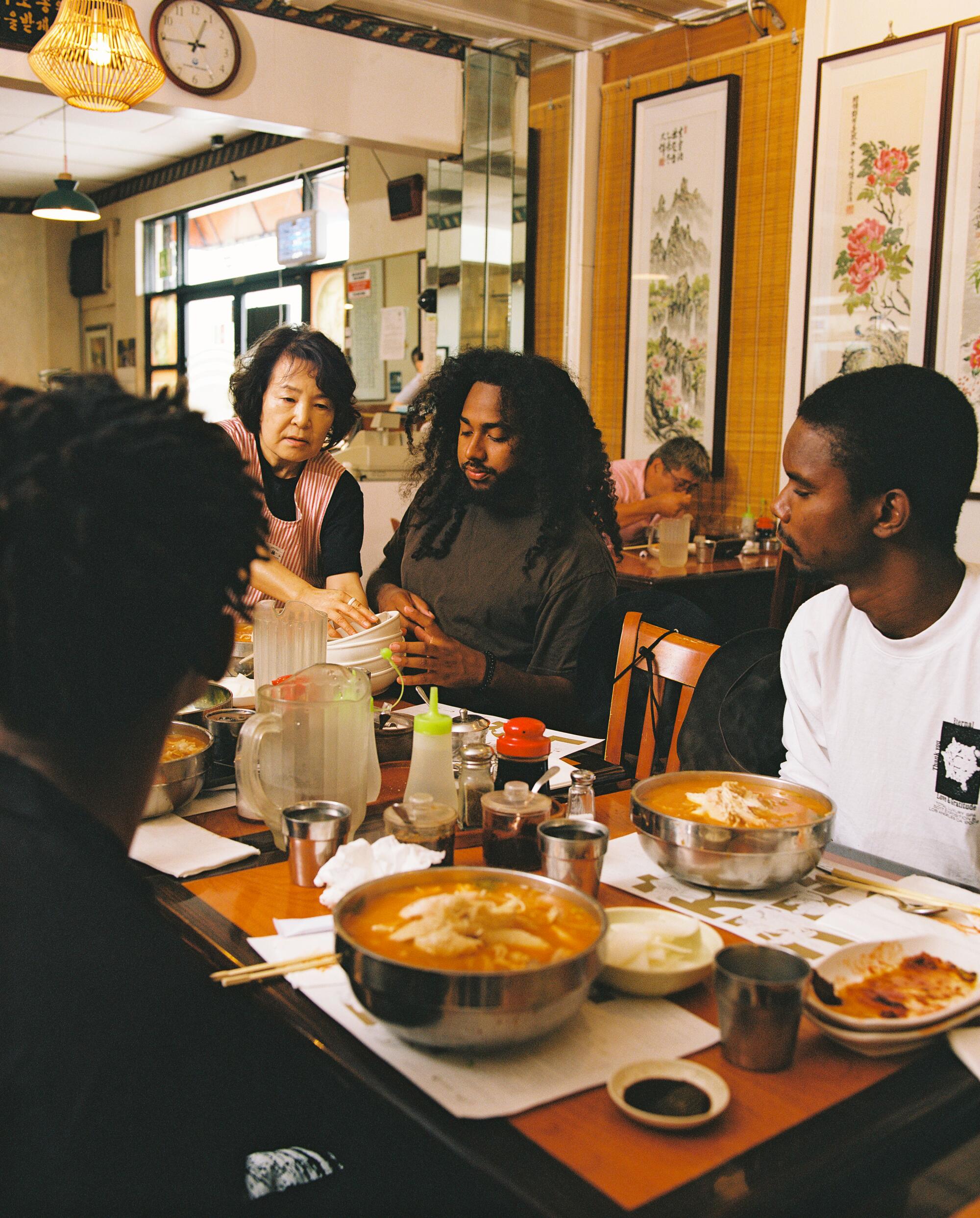
IFB: The empathy really comes through in a number of these projects, both in terms of the messaging but also, there’s usually something that you’ve kind of inverted that then alters the POV. How do you inject or submit the brand to becoming this empathetic device?
DD: As we ingest culture, the conversation evolves. What a shirt meant five years ago and means today is very different. These things evolve, graphics evolve, especially with things like social media — people see one thing and it’s remotely popular, everyone’s doing the thing. I think terms like “wellness” have been so overused. Even “community” — sometimes I’m hesitant to use that term.
IFB: In a few pieces I read, Total Luxury Spa was labeled a wellness brand. How do you feel about that?
DD: We get labeled that a lot. I think it’s strange — it means that people expect that every single step of the way you’re gonna be doing something that’s always gonna give back. We do that every single chance that we get. But also the term “wellness” has been so beaten up. What does that really mean?
Bespoke clothing is not an everyday occurrence in L.A. But for Erik Kim and Paul Um, creating a one-of-one piece is a religious experience.
IFB: I’m very interested in the possibility of an image — what the limitations of an image are. When you’re designing a shirt, and it has a very specific thing that it wants to say, how does that connect with what might be considered good design? What can a saying or visual do and how does that compare to somebody crafting a suit from scratch?
DD: Someone once told me: The businessman did to the suit what religion did to spirituality. The suit used to be this representation of empowerment — you could get on a plane in it, it was comfortable. And then at some point, people had to put suits on to go to work and it represents something else all of a sudden. Hopefully, what we can do with a shirt and communication is bring back a level of empowerment, bring back a level of conversation. We’re hoping that people ask, “Where’d you get that shirt?” And it asks a question and kind of answers it back or maybe you answer it back, and there’s a real kind of dialogue. To me, the best art in the world does that.
In terms of graphic design, it’s like a poem about love without ever using the word love. Which I think in writing is probably some Writing 101 thing.
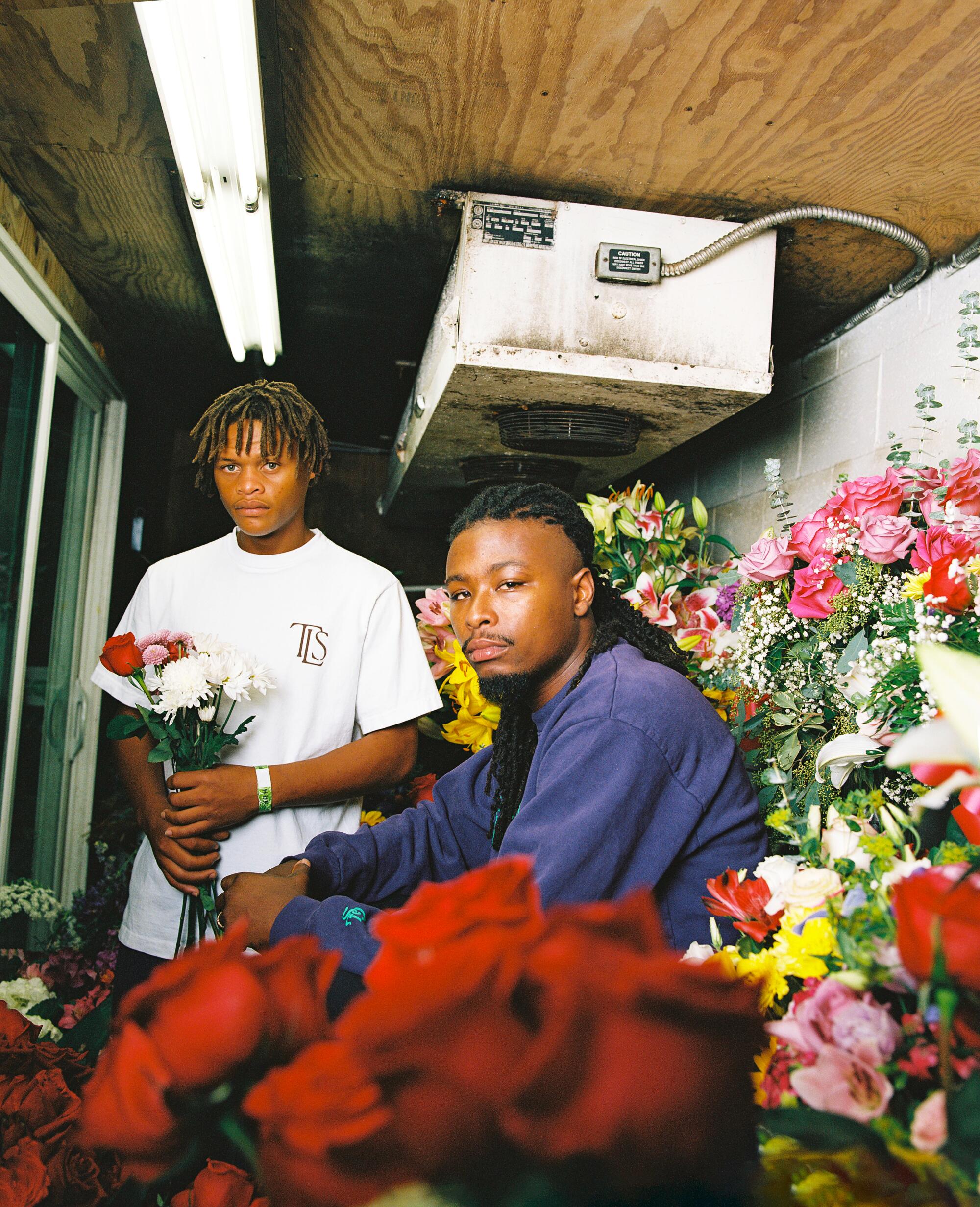
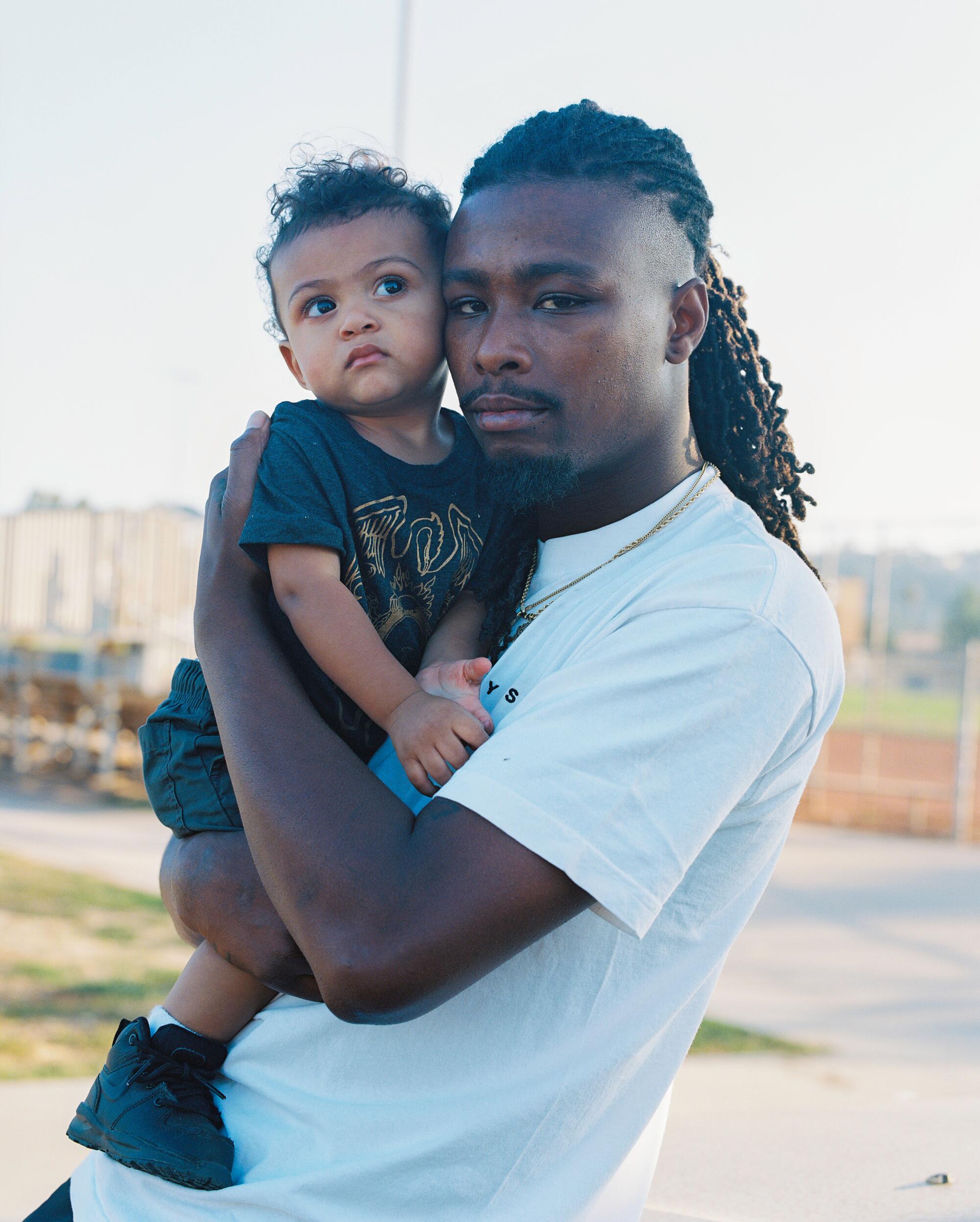
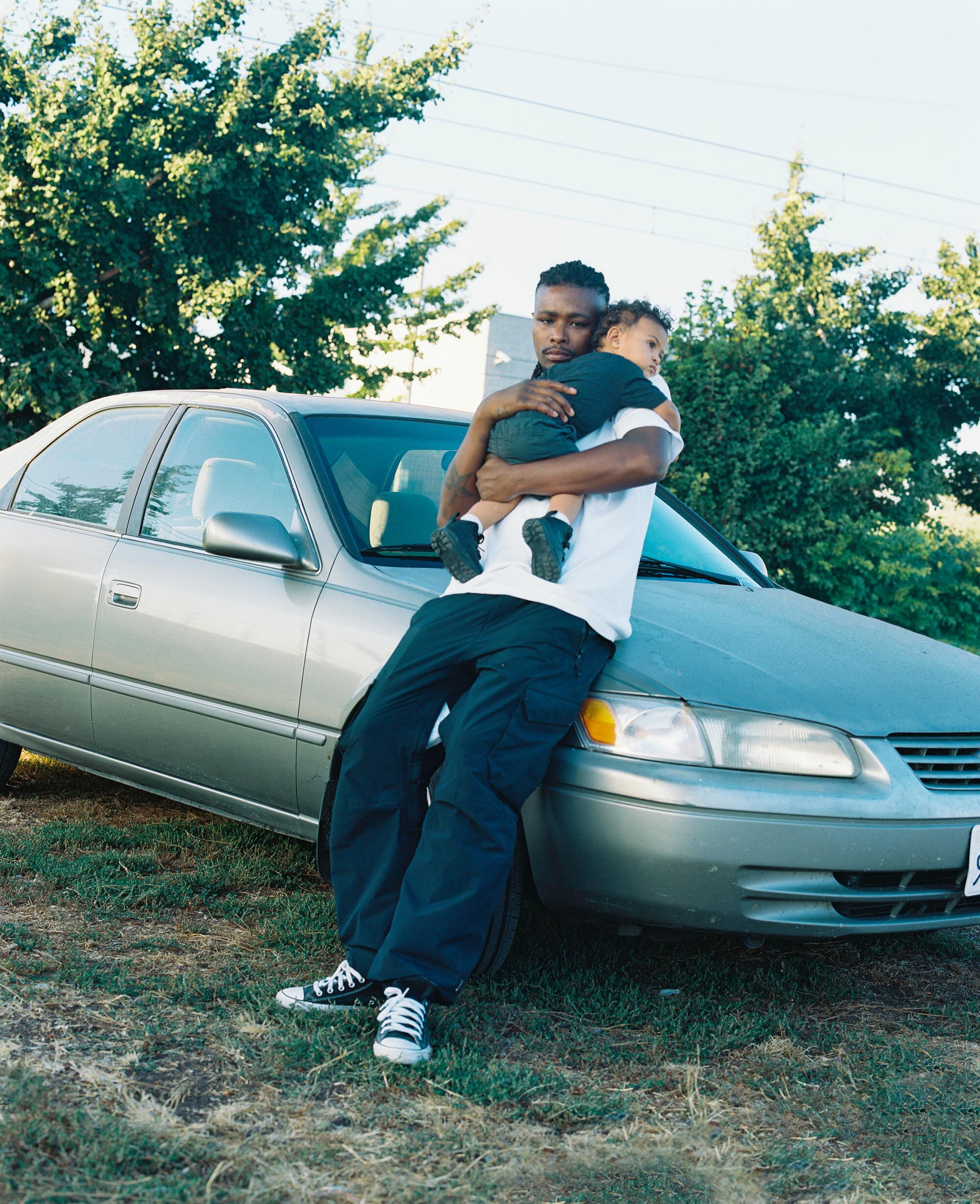
IFB: I think it’s just called show, don’t tell.
DD: Exactly. And in a graphic way, we start there first. There’s a lot of low-hanging fruit in terms of design. I think part of the reason I’m so into fine art is because, to me, fine art is about a conversation almost before anything else. Some of the best artists that I know are the ones where my mind is blown, I leave a space thinking about it. I continue to think about it a week later. And I think that conversation is going to change, it has to always evolve.
When we’re designing, because we’re always so interested in the past — past designers, past artists, we collect and we archive — that’s kind of where we start from an aesthetic standpoint. A lot of our stuff doesn’t feel tech or digital or new — it’s rare that we’re looking at new typefaces. We do a little bit, but a lot of times, the ones that we’re interested in are a new version of something that’s a throwback. We have a bit of a formula for how much we are turning the dial up: Is it something that we need to say right now? Is it really important? How do we communicate it? If it’s a collaborative project with someone else, what is their aesthetic? What is their conversation? We did a project with Simply Wholesome up the street. When we did, we wanted to know the history of Simply Wholesome. Can you share family photos with us, some of the early type, some of the early illustrations that were done? We started making things from there. It’s a real look at the history of Simple Wholesome.
IFB: I’m looking at this graphic over your shoulder, “The geography of hope.” The word “hope” seems to come through with TLS. Do you have any specific desire for showing or showcasing hope? Or giving people hope through what you’re doing?
DD: I think so. When we make anything, from writing to art, there’s this idea of hope to connect with other people for them to understand it, for them to maybe carry the torch to the next generation. I think hope and empathy are the two big staples. Not to sound hokey, and maybe I’ve just become a little bit softer with my old age, but I just think it’s daunting out there.
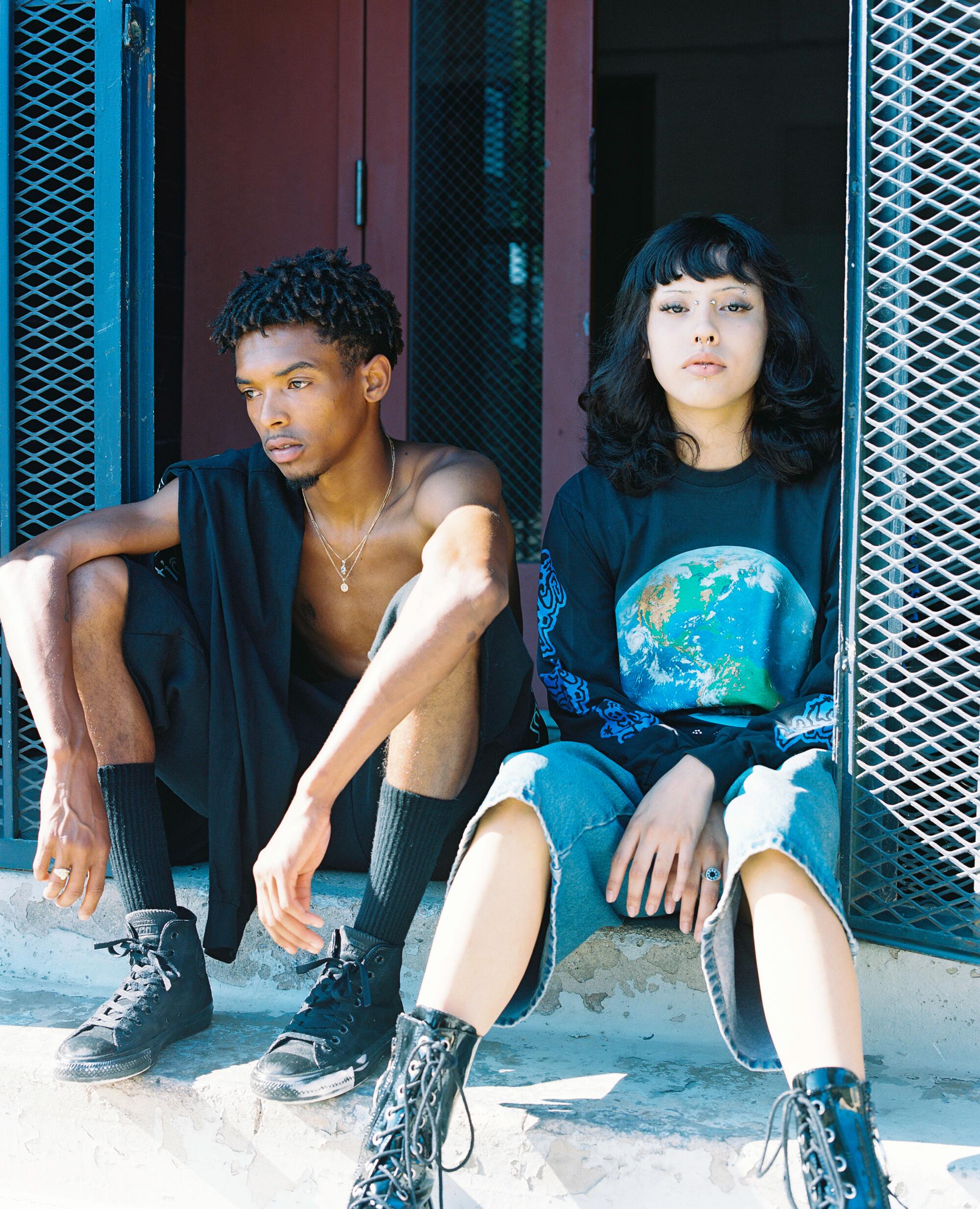
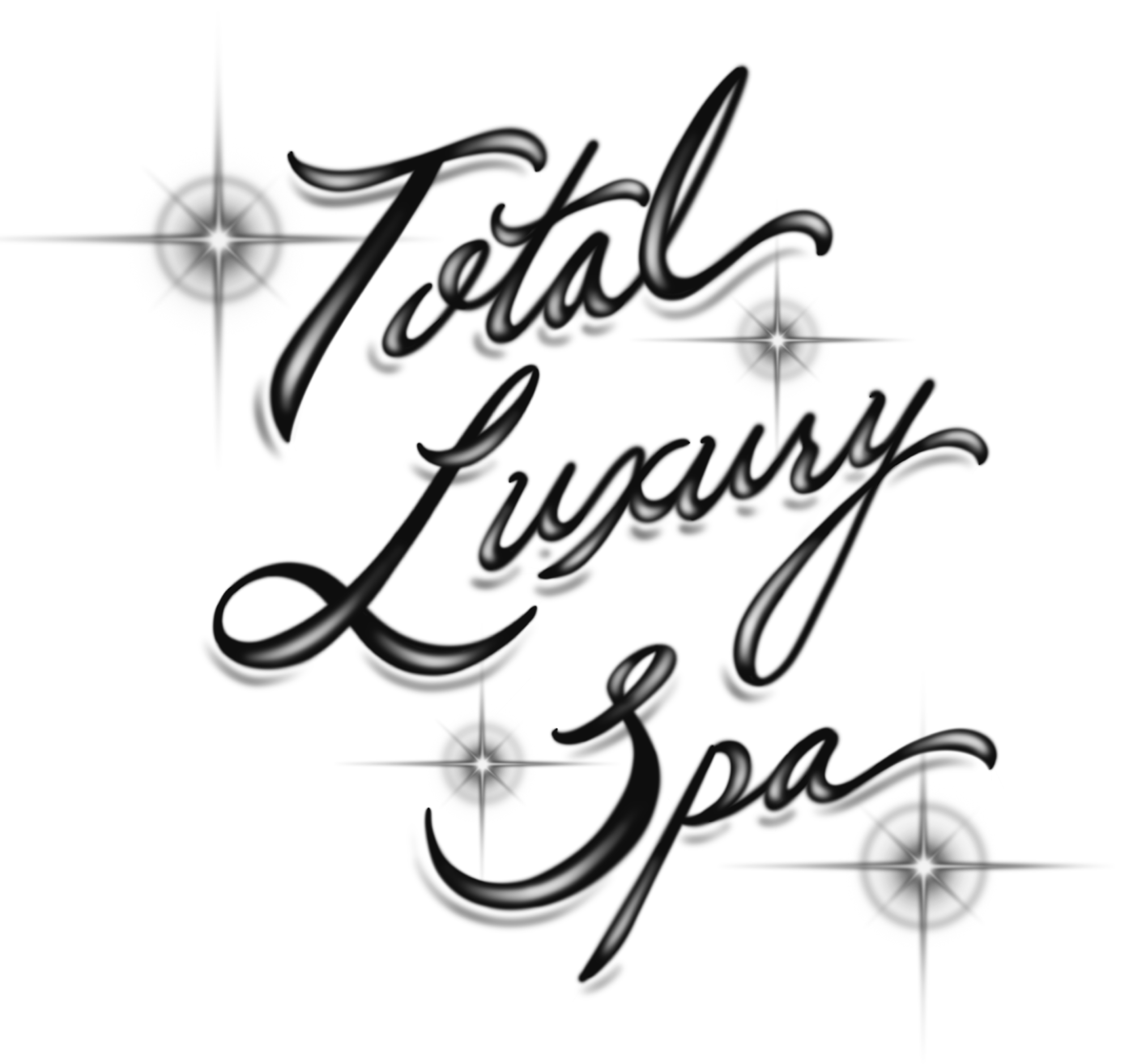
Lettering by Jake Garcia / For The Times

